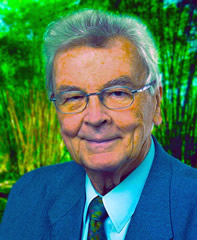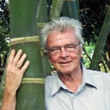Dr Walter Liese (1926-2023)
Click on thumbnails and links for enlarged or expanded content.
After short illness Prof. Dr. Dr. h.c. mult. Walter Liese peacefully passed away on 24 February 2023 at the age of 97 years in his home in Reinbek close to Hamburg. The worldwide wood science community lost an extraordinary researcher, university teacher, networker, colleague, and friend.
Born on 31 January 1926 in Berlin, Walter Liese grew up in the nearby city of Eberswalde, where his father Johannes Liese was professor at one of the worldwide oldest forestry universities. Already as a pupil he therefore came into close touch with forestry and wood science through his father’s work. After finishing school, in 1944 Walter Liese had to serve in the German army until the end of the war, fortunately without any injuries. Starting in 1946, he successfully studied forest science in Freiburg with his diploma in 1950. In 1951, he finalized his doctoral thesis at the Forest Botanical Institute in Hannoversch-Münden of the University of Goettingen at the age of 25. Contacts to Ernst and Helmut Ruska (1986 Nobel Prize for Ernst Ruska for his pathbreaking work in the construction of the electron microscope) enabled him to use one of the worldwide first electron microscopes for studies on the fine structure of wood, soon publishing the first electron micrograph of a softwood bordered pit membrane with torus and margo. Walter Liese was a pioneer in electron microscopy also developing proper preparation techniques, especially the replica technique to overcome desiccation artefacts during analyses in the vacuum of an electron microscope. Several cooperation’s, e.g., with Hiroshi Harada in Japan, Eric Dadswell and Alan Wardrop in Australia, Vladimir Necesany in Slovakia, resulted in a number of new findings on the fine structural details of cell walls in woody tissue, among them the discovery of the warty layer as the innermost layer in tracheids of many softwoods. Occurrence, forms, and systematic significance were later investigated for about 120 soft- and hardwood species.
In 1959, Walter Liese took over a position at Munich University, and in 1963 he was appointed professor for wood biology and wood protection at Hamburg University. Through the contract cooperation to the Federal Research Centre for Forestry and Forest Products he became at the same time director of the Federal Institute of Wood Biology and Wood Protection, both institutions in the same buildings, first in the Reinbek castle, later in the newly built laboratories in Hamburg-Bergedorf. During the iron curtain period in Europe, he was quite successful in establishing and maintaining contacts to wood scientists in eastern Europe, which was highly and thankfully acknowledged by honorary doctor ships dedicated from the universities in Zvolen (Slovakia), Warsaw (Poland), Poznan (Poland), and Ljubljana (Slovenia). Not only in Europe but worldwide he was diplomat, motivator and bridge builder in all aspects of wood and forestry science. As a consequence, he was elected IUFRO president for the period 1977-1981.
Walter Liese was an expert in wood science, but also an enthusiastic researcher in the anatomy of bamboo and rattan. Over 500 publications and several books are well documenting his enormous scientific work. Even after his retirement in 1991 he continued with his research and published numerous papers in national and international journals as well as some books on bamboo anatomy and utilization. In 1966 he was involved in the foundation of the International Academy of Wood Science and was one of the first elected fellows. Walter Liese was elected Vice-President of the Academy for the period 1978-1981, but could not accept office due to his election as IUFRO president. He served as editor of the Academy’s journal “Wood Science and Technology” from the first issue in 1966 until 1995.
Walter Liese’s scientific contributions live on in his many publications which will have a lasting impact in wood science. His pathbreaking achievements in the fields of wood fine structure, wood protection, the use of bamboo and rattan as a raw material, his fundamental work of wound reactions and tree care have attracted worldwide attention. After a long life for science, Walter Liese will be greatly missed.
Uwe Schmitt and Gerald Koch, Hamburg
This Memorial was written for inclusion with the April 2023 IRG Newsletter.










